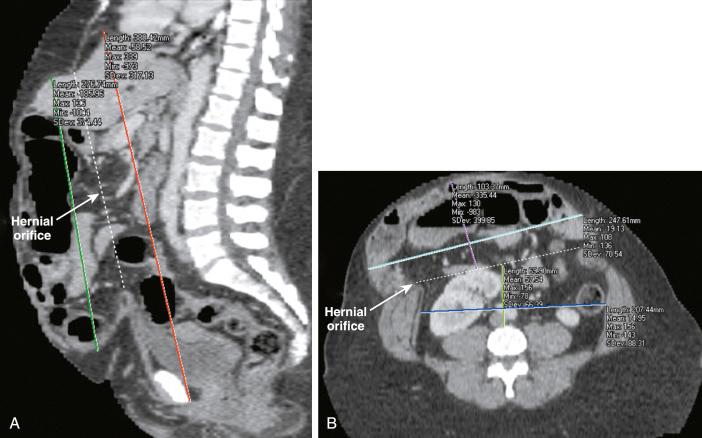Physical Address
304 North Cardinal St.
Dorchester Center, MA 02124
Definition of loss of abdominal domain: There is no consensus in the literature on the definition of loss of abdominal domain. Determination of this condition is subjective and typically refers to massive hernias with a significant amount of intestinal contents that have herniated through the abdominal wall into a hernia sac that forms a secondary abdominal cavity. On physical examination, the inability to reduce the herniated contents below the level of the fascia when the patient is lying supine should raise suspicion of the diagnosis. Although the surgeon can often make the assumption that a patient has loss of domain on physical examination, we use computed tomography (CT) to determine the true nature of the hernia.
We define a loss of abdominal domain on CT scan as greater than 40% of the intestinal contents lying outside the native abdominal cavity in the hernia sac. It may be more accurately defined when the ratio of the volume of the hernia sac to the volume of the abdominal cavity is 0.4 or greater.
A sagittal reconstruction of the CT scan is used to measure the length of the hernia sac from the top to the bottom of the sac. The length of the abdominal cavity is measured from the top of the diaphragm to the inferior aspect of the symphysis pubis ( Fig. 16.1A ).

Axial reconstructions are used to measure the width of the hernia sac and abdominal cavity at their widest point. The height of the hernia sac is measured from an imaginary line drawn across the hernial orifice to the apex of the hernia sac at its tallest portion. The height of the abdominal cavity is measured from the anterior portion of the fourth lumbar space to an imaginary line drawn across the hernial orifice ( Fig. 16.1B ).
Using the formula to measure the volume of an ellipsoid (V = 4/3 × π × r1 × r2 × r3), the hernia sac and abdominal cavity volumes can be measured and compared. To simplify the ellipsoid volume equation, the length, height, and width measurements of the cavities are multiplied by a factor of 0.52 (V = 0.52 × L × H × W). Loss of domain exists when the ratio of the volume of the hernia sac to the volume of the abdominal cavity is 0.4 or greater.
In patients with loss of abdominal domain, the bowels reside outside the abdominal cavity. As intra-abdominal pressure decreases to approach atmospheric pressure, abdominal viscera become edematous, and their vasculature becomes engorged. This situation makes simple hernia reduction nearly impossible. In addition, respiratory function is altered secondary to the loss of diaphragmatic support, and anterior spinal support fails, leading to lordosis.
The immediate reintroduction of viscera and abdominal reconstruction in patients with loss of domain can result in a significant increase in intra-abdominal pressure, which can lead to abdominal compartment syndrome and its resultant ill effects. Progressive preoperative pneumoperitoneum (PPP) attenuates the adverse physiologic effects associated with ventral hernia repair in patients with a loss of abdominal domain.
Insufflation of the abdominal cavity acts as an intraperitoneal pneumatic tissue expander. The expansion serves to increase the length of the oblique musculature, increasing the diameter of the abdomen and subsequently increasing the volume of the abdominal cavity. This allows for adequate accommodation for the herniated contents.
The pneumoperitoneum also dissects throughout the intraperitoneal cavity, providing a pneumatic lysis of adhesions aided by gravity as the bowels are suspended by their adhesions within the hernia sac.
Physiologically, PPP slowly creates a chronic abdominal compartment syndrome. With decreased diaphragmatic excursion, the patient is forced to overcome the inherent decreased inspiratory capacity. Additionally the adverse cardiovascular effects of acute abdominal compartment syndrome are attenuated by the slow introduction of intraperitoneal air.
Become a Clinical Tree membership for Full access and enjoy Unlimited articles
If you are a member. Log in here